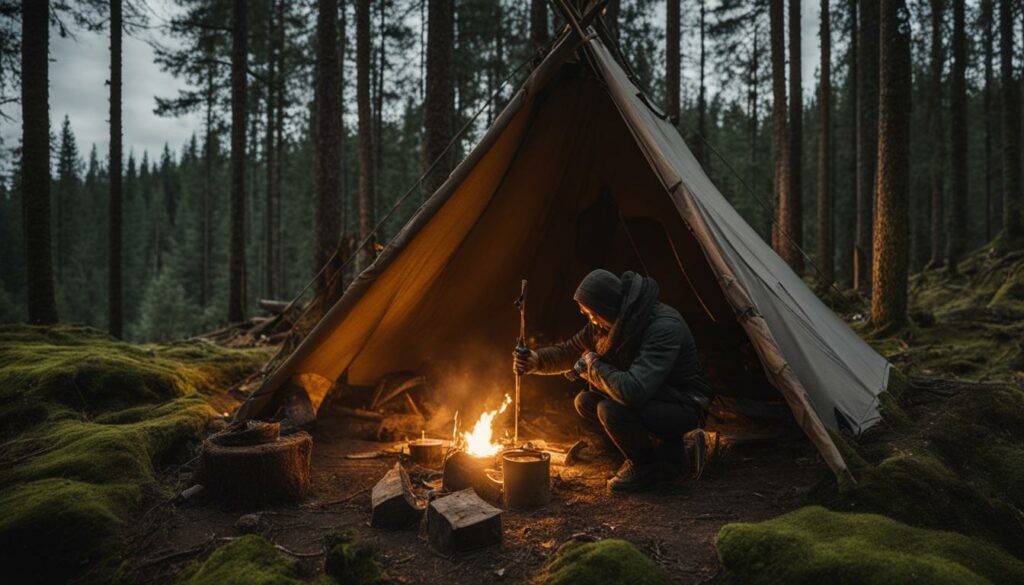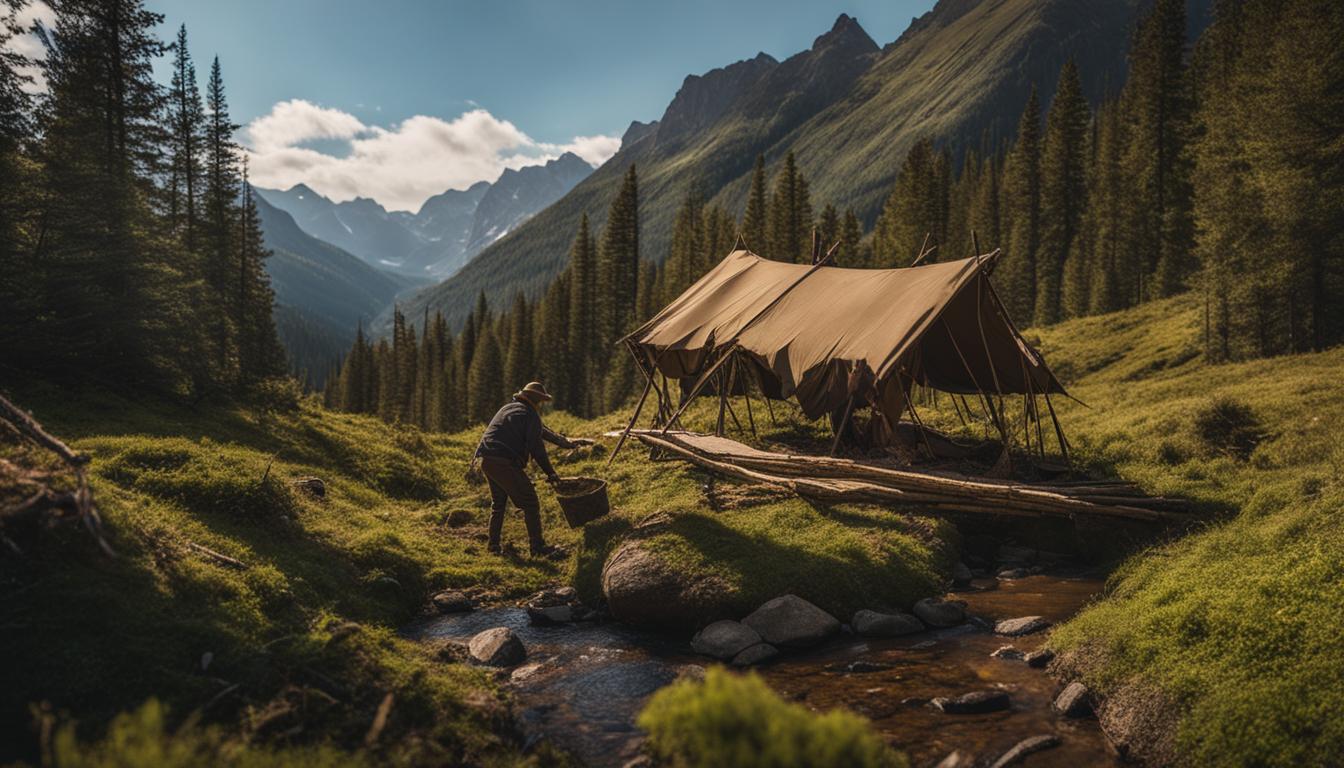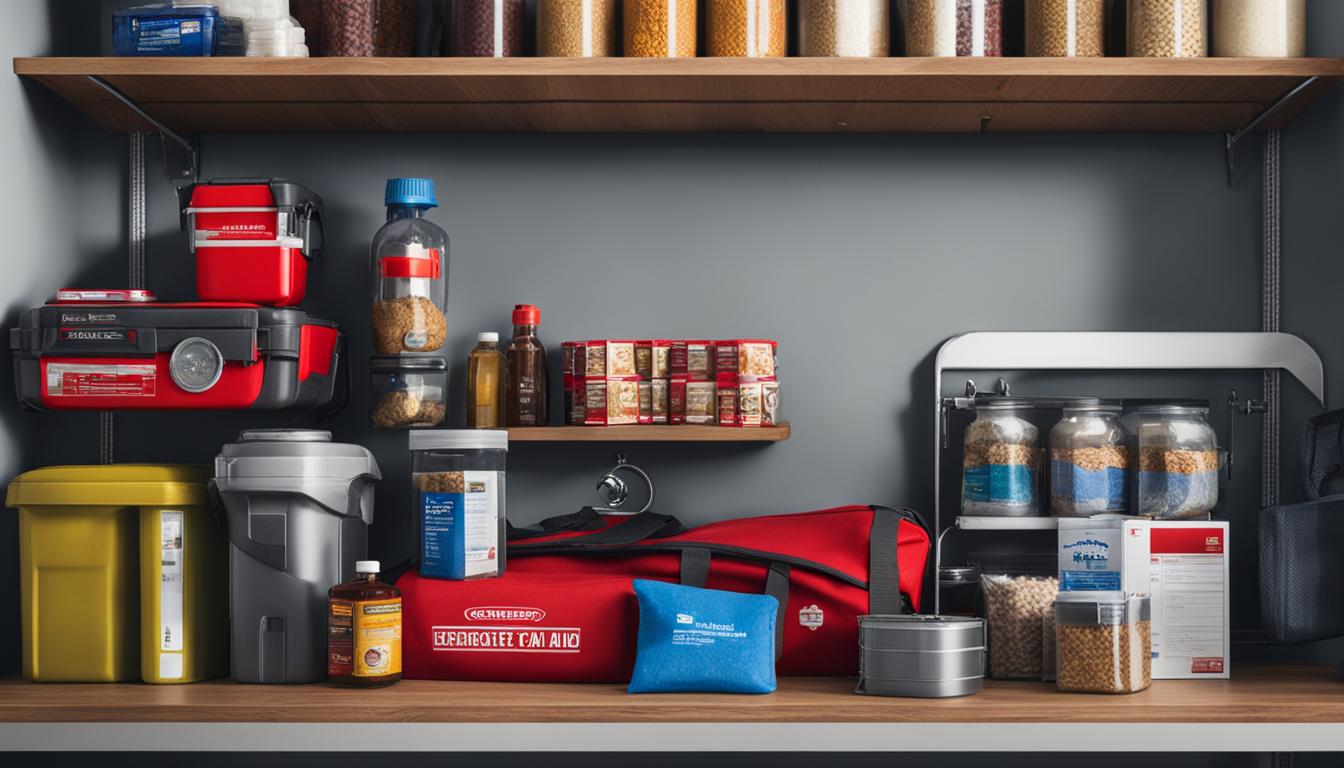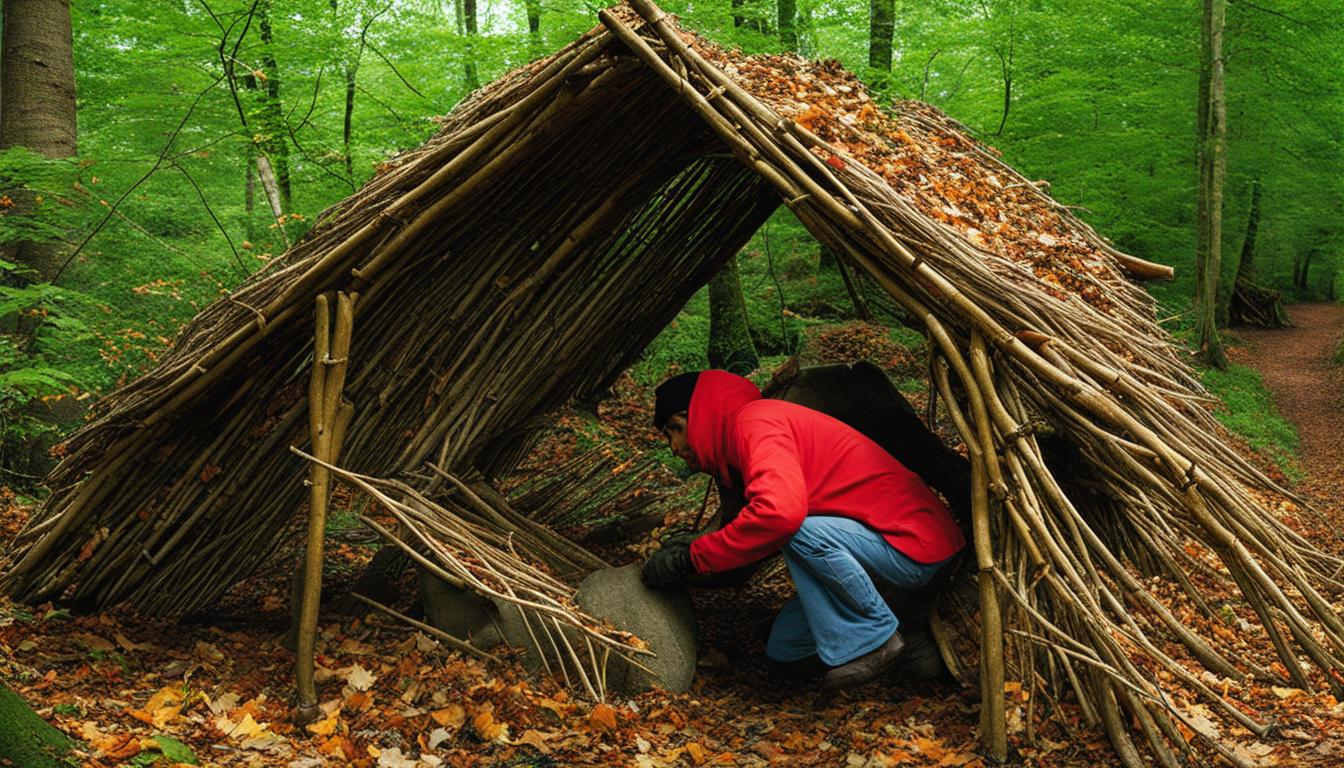Welcome to the definitive resource for perfecting wilderness skills and excelling in the outdoor world. Whether you’re an experienced explorer or just starting out, this all-encompassing guide will provide you with the expertise and strategies necessary to navigate the wilderness, endure tough circumstances, and establish a profound connection with nature.
From bushcraft techniques to primitive skills, this guide covers it all. Learn how to navigate through unfamiliar terrain, build a shelter, start a fire, forage for food, and administer first aid in the wild. With these essential wilderness skills, you’ll be prepared for any outdoor adventure and confident in your ability to overcome obstacles.
Key Takeaways:
- Master wilderness skills to enhance your outdoor adventures and ensure your safety in remote wilderness areas.
- Develop navigation techniques using tools such as a compass and map to confidently explore unfamiliar terrain.
- Learn essential wilderness survival tips, including identifying edible plants, building shelters, and starting a fire.
- Gain knowledge of wilderness first aid techniques to handle emergencies and injuries in the wild.
- Explore primitive skills and connect with nature on a deeper level by learning ancient survival techniques.
The Importance of Wilderness Skills
Developing wilderness skills is crucial for anyone who enjoys outdoor activities and wants to be prepared for any situation. These skills not only enhance your camping and hiking experiences but also ensure your safety and survival in remote wilderness areas. Whether you’re a beginner or an experienced adventurer, mastering these skills will give you the confidence and knowledge to explore the wild with ease.
When venturing into the wilderness, it’s essential to have a solid foundation of wilderness skills. These skills allow you to navigate through unfamiliar terrain, build shelters, find food, and apply first aid when needed. By honing your wilderness skills, you become self-reliant and capable of handling unexpected challenges that may arise during your outdoor adventures.
Wilderness camping requires more than just packing the right gear and equipment. It demands a certain level of knowledge and expertise in various areas, such as navigation, survival techniques, and foraging. With the right wilderness skills, you can confidently embark on solo expeditions or lead group trips, knowing that you have the ability to adapt and thrive in different environments.
The Benefits of Wilderness Skills
Mastering wilderness skills offers numerous benefits beyond survival and safety. It allows you to develop a deeper connection with nature, as you learn to rely on the resources available in the wild. Wilderness skills also promote self-sufficiency and foster a sense of independence, empowering you to explore remote areas with confidence.
Additionally, wilderness skills provide a gateway to unique experiences and opportunities. By immersing yourself in the natural world and acquiring knowledge of the plants, animals, and ecosystems around you, you gain a deeper understanding and appreciation of the environment. This knowledge can be shared with others, fostering a sense of community and inspiring a love for the outdoors.
Whether you’re an avid hiker, a nature enthusiast, or simply someone who wants to be prepared for any outdoor situation, investing time and effort into developing wilderness skills is invaluable. The knowledge and confidence gained from mastering these skills will not only enhance your outdoor adventures but also provide a foundation for a lifetime of exploration and discovery in the wild.

Navigation Techniques for the Wilderness
When venturing into the wilderness, having the ability to navigate through unfamiliar terrain is crucial for your safety and survival. In this section, we will explore essential navigation techniques that will guide you on your outdoor adventures. Whether you are an experienced hiker or a beginner camper, these skills will enable you to confidently find your way in the wild.
One key tool for wilderness navigation is a compass. By understanding how to use a compass, you can determine your direction and navigate according to a map. Reading topographic maps is another essential skill that allows you to interpret elevation changes and identify landmarks in the wilderness. Combining these techniques will give you a comprehensive understanding of your surroundings and help you plan your route.
Landmarks play a significant role in wilderness navigation. By identifying prominent features in the environment, such as mountains, rivers, or distinct trees, you can use them as reference points while navigating. Additionally, understanding the principles of orienteering, including triangulation and back-bearings, will further enhance your ability to navigate accurately.
Table: Navigation Tools
| Tool | Description |
|---|---|
| Compass | A magnetic tool that points towards the Earth’s magnetic north |
| Topographic Maps | Detailed maps that represent natural and man-made features of an area |
| Landmarks | Prominent features in the landscape used as reference points |
| Orienteering Principles | Techniques for determining direction and location using a compass or landmarks |
By mastering these navigation techniques and using the right tools, you will be able to confidently explore the wilderness and navigate through challenging terrains. Remember to practice these skills in various environments to ensure your proficiency and to always carry a map and compass on your outdoor adventures.
Essential Wilderness Survival Tips
When venturing into the wilderness, it’s crucial to have a range of essential survival tips in your arsenal. These tips will not only help you navigate through challenging situations but also increase your chances of staying safe and thriving in the wild. From finding food to building shelters, here are some key wilderness survival tips to keep in mind:
1. Identify and Forage for Edible Plants
Knowing how to identify edible plants in the wild can be a lifesaver when food sources are scarce. Familiarize yourself with the native vegetation in your area and learn to recognize edible plants, berries, nuts, and mushrooms. Look for resources such as field guides or online sources to help you differentiate between edible and poisonous plants.
2. Master Shelter Building Techniques
A sturdy shelter is essential for protection against the elements in the wilderness. Learn different shelter-building techniques, such as constructing a debris shelter or setting up a tarp shelter. Understanding how to find suitable locations and gather natural materials will enable you to create a safe and comfortable shelter to withstand harsh weather conditions.
3. Start a Fire Using Natural Materials
Fire is crucial for warmth, cooking, and signaling for help in the wilderness. Practice starting a fire using natural materials such as dry leaves, twigs, and rocks. Learn different fire-starting techniques, such as the bow drill or fire plow method, to increase your chances of success. Remember, fire safety is paramount, so always ensure you have control over your fire and properly extinguish it when no longer needed.
4. Stay Hydrated and Purify Water
Access to clean water is vital for survival in the wild. Learn how to find water sources such as rivers, streams, or natural springs. However, it’s important to purify any water you consume to avoid waterborne illnesses. Familiarize yourself with different water purification methods, such as boiling, using water filters, or purifying tablets, to ensure your water is safe to drink.
| Essential Wilderness Survival Tips | Description |
|---|---|
| Identify and Forage for Edible Plants | Learn to recognize edible plants, berries, nuts, and mushrooms in the wild. |
| Master Shelter Building Techniques | Acquire the skills to construct sturdy shelters using natural materials. |
| Start a Fire Using Natural Materials | Practice different methods of starting a fire using materials found in the wilderness. |
| Stay Hydrated and Purify Water | Find water sources and learn how to purify water for safe consumption. |
Remember, these are just a few key wilderness survival tips to get you started. Continuously educating yourself, practicing these skills, and gaining experience in the wilderness will significantly improve your chances of survival and ensure you make the most of your outdoor adventures.

Wilderness First Aid
Accidents and injuries can happen at any time during outdoor adventures, making knowledge of wilderness first aid techniques essential. Whether you’re miles away from civilization or exploring remote wilderness areas, being prepared to handle medical emergencies is crucial for your safety and the well-being of others.
Wilderness first aid encompasses a range of skills and knowledge specific to outdoor environments. It involves understanding how to assess and treat injuries and illnesses that may occur in the wilderness, where access to medical facilities may be limited or unattainable.
Some key wilderness first aid techniques include:
- Providing CPR and managing cardiac emergencies
- Treating cuts, wounds, and burns
- Handling fractures and sprains
- Managing heat-related illnesses
- Dealing with hypothermia and frostbite
- Administering basic medications and pain relief
When practicing wilderness first aid, it’s important to have a well-stocked first aid kit specifically tailored to outdoor emergencies. This kit should include items such as adhesive bandages, antiseptic wipes, gauze pads, a splint, pain medication, and instructions for administering first aid in wilderness settings.

Table: Essential Components of a Wilderness First Aid Kit
| Item | Function |
|---|---|
| Adhesive bandages | To cover small cuts and scrapes |
| Gauze pads | To dress larger wounds |
| Antiseptic wipes | To clean and disinfect wounds |
| Splint | To immobilize fractures and sprains |
| Pain medication | To provide relief from pain |
| Instructions | For administering first aid in wilderness settings |
Remember, in case of a serious medical emergency, it’s important to seek professional medical help as soon as possible. Wilderness first aid skills are meant to stabilize a situation and provide temporary relief until proper medical assistance can be obtained.
Primitive Skills for Survival
Immerse yourself in the captivating world of primitive skills and learn ancient techniques that can save your life in the wilderness. These skills, honed by our ancestors, are still relevant today and offer a deep connection with nature and self-reliance in outdoor survival situations. From making fire without modern tools to constructing primitive shelters and hunting for food, mastering these skills will ensure your ability to thrive in the wild.

Primitive Fire-making Methods
Building a fire is one of the essential skills for survival. In the primitive world, fire was created using friction, such as rubbing sticks together. Learn the art of fire-making through friction and discover various techniques like the hand drill and the bow drill. With practice and patience, you can master these methods and be able to start a fire without modern tools. Fire provides warmth, light, and the ability to cook food, making it a crucial skill for survival in the wild.
Primitive Shelter-building
When faced with the elements, having a shelter is essential for protection and comfort. Primitive shelter-building techniques rely on using natural materials found in the environment. Learn how to construct a debris hut, a simple yet effective shelter built from branches, leaves, and other natural materials. These shelters provide insulation and protection from wind and rain, increasing your chances of survival in adverse weather conditions.
Primitive Hunting and Trapping Techniques
In a survival situation, obtaining food is a top priority. Primitive hunting and trapping techniques allow you to procure food using minimal tools. Learn how to create primitive snares, traps, and weapons to catch small game. Develop your tracking skills and knowledge of animal behavior to increase your chances of success. Mastering these techniques will give you the ability to sustain yourself with protein-rich food sources in the wild.
By embracing primitive skills, you gain a deeper understanding of our ancestors’ way of life and their connection with the natural world. These skills not only ensure your survival in the wilderness but also provide a sense of fulfillment and self-sufficiency. Remember, practice is key to mastering primitive skills, so get out into the wild and embark on your journey of discovery and self-reliance.
Foraging in the Wild
One of the most valuable wilderness skills you can develop is the ability to forage for food in the wild. Foraging allows you to connect with nature on a deeper level and provides you with a sustainable food source during your outdoor adventures. By learning to identify edible plants, berries, nuts, and mushrooms, you can expand your diet and add variety to your meals.
When foraging in the wild, it’s important to educate yourself about the local ecosystem and the specific plants that grow in the area. There are numerous resources available, including field guides and online databases, that can help you learn to identify edible plants and avoid any potentially harmful ones. Take the time to familiarize yourself with the different species and their characteristics before venturing into the wilderness.
Edible Plants in North America
| Plant Name | Description | Season | Location |
|---|---|---|---|
| Dandelion | A common weed with edible leaves and flowers. The leaves can be used in salads, while the flowers can be used to make tea or jelly. | Spring, Summer, Fall | Widespread |
| Purslane | A succulent plant with thick leaves that have a slightly tangy flavor. The leaves can be eaten raw or cooked and are rich in omega-3 fatty acids. | Summer | Widespread |
| Blackberries | A sweet and juicy fruit that grows on thorny bushes. They are a rich source of antioxidants and can be eaten fresh or used in various recipes. | Summer | Wooded areas |
| Chanterelle Mushroom | A highly prized mushroom with a delicate, fruity flavor. They are best enjoyed sautéed or added to soups and sauces. | Summer, Fall | Forest floors |
When foraging, it’s essential to follow sustainable practices to ensure the continued growth and abundance of the plants you harvest. Only take what you need and leave enough behind for the plants to regenerate. Additionally, be mindful of your surroundings and avoid foraging near areas that may be contaminated, such as roadsides or industrial sites.
Foraging in the wild is a rewarding and enriching experience that allows you to connect with nature and discover the abundance of resources available in the wilderness. By learning to identify edible plants and practicing sustainable foraging techniques, you can enhance your outdoor survival skills and enjoy a deeper connection with the natural world.
Bushcraft Techniques for Outdoor Adventure
When it comes to outdoor survival, mastering bushcraft techniques is essential. These skills not only enhance your camping experience but also enable you to thrive in the wilderness. From knife skills and knot tying to shelter construction and campfire cooking, bushcraft techniques provide a sense of self-reliance and enable you to live off the land more comfortably.
One of the fundamental skills in bushcraft is knife handling. A sharp and reliable knife is a versatile tool that can be used for various tasks, such as preparing food, creating firewood, and building shelters. It’s crucial to learn proper knife techniques, including how to safely handle and maintain your knife, as well as different cutting and carving methods.
In addition to knife skills, mastering knot tying is essential for creating sturdy structures and securing equipment. Knowing how to tie different knots, such as the clove hitch and the bowline knot, allows you to construct shelters, set up traps, and secure gear in a reliable and efficient manner.
Table: Essential Bushcraft Techniques
| Technique | Description |
|---|---|
| Shelter Construction | Learn how to build different types of shelters, including lean-tos, debris huts, and teepees, using natural materials. |
| Campfire Cooking | Discover various methods for cooking food over an open fire, such as using a spit, grilling on a grate, or cooking in a Dutch oven. |
| Water Sourcing and Purification | Understand how to find and collect water in the wilderness, as well as different techniques for purifying water to make it safe for drinking. |
| Primitive Fishing | Learn how to catch fish using primitive tools and techniques, such as making a fishing spear or constructing a fish trap. |
| Tracking and Observation | Develop your tracking skills and learn how to interpret animal signs, track game, and observe wildlife in their natural habitat. |
“Bushcraft techniques provide a sense of self-reliance in the wilderness.”
Bushcraft techniques not only equip you with practical skills but also foster a deeper connection with nature. By immersing yourself in these techniques, you develop a greater appreciation for the resources and beauty of the natural world. So, embrace the adventure and explore the world of bushcraft to enhance your outdoor experiences and thrive in the wild.

Gear and Equipment for Wilderness Survival
In order to ensure your safety and comfort in the wilderness, it is essential to have the right gear and equipment. Whether you are embarking on a day hike or a multi-day adventure, being well-prepared with the necessary items can make a significant difference in your outdoor survival. Here are some key gear and equipment recommendations to consider:
Sleeping Gear
A good night’s sleep is crucial when spending time in the wilderness. Invest in a high-quality sleeping bag that suits the climate you will be in. Look for one that is lightweight, durable, and offers adequate insulation. Additionally, a comfortable sleeping pad or mat will provide insulation from the ground and enhance your overall sleeping experience.
Clothing and Footwear
Dressing appropriately for the wilderness is essential to protect yourself from the elements. Layering your clothing is the key to regulating your body temperature. Choose moisture-wicking base layers, insulating mid-layers, and a waterproof and breathable outer layer. Don’t forget to wear a hat, gloves, and thick socks to keep extremities warm. As for footwear, opt for sturdy, waterproof boots that provide ankle support and have a good grip on varying terrains.
Camping and Cooking Equipment
To set up camp and prepare meals in the wilderness, you’ll need the right equipment. A reliable tent that is lightweight, waterproof, and easy to set up will provide shelter and protection from the elements. A camping stove or portable grill, along with cookware and utensils, will allow you to cook meals and boil water. Additionally, pack a water filtration system or purification tablets to ensure a clean and safe water supply.
Survival Tools and First Aid Kit
Carry essential survival tools such as a knife, multi-tool, and fire starter kit. These tools will assist with various tasks such as food preparation, repairing gear, and starting a fire for warmth and cooking. Additionally, a well-stocked first aid kit containing bandages, antiseptic ointment, pain relievers, and other medical supplies should always be included in your gear. Familiarize yourself with basic first aid procedures to handle minor injuries and emergencies.
Navigation and Communication
When venturing into the wilderness, it is crucial to have reliable navigation tools such as a map, compass, and GPS device. These tools will help you navigate and stay on the right track. Additionally, consider bringing a reliable communication device such as a satellite phone or a personal locator beacon (PLB) in case of emergencies.
| Item | Recommendation |
|---|---|
| Sleeping Bag | High-quality, lightweight, and suitable for the climate |
| Sleeping Pad or Mat | Insulating and comfortable |
| Clothing | Moisture-wicking base layers, insulating mid-layers, waterproof and breathable outer layer |
| Footwear | Sturdy, waterproof boots with ankle support and good traction |
| Tent | Lightweight, waterproof, and easy to set up |
| Camping Stove or Portable Grill | For cooking meals and boiling water |
| Cookware and Utensils | Essential for meal preparation |
| Water Filtration System or Purification Tablets | For ensuring a clean and safe water supply |
| Knife and Multi-tool | For various tasks and repairs |
| Fire Starter Kit | For starting fires |
| First Aid Kit | Well-stocked with bandages, antiseptic ointment, pain relievers, etc. |
| Map, Compass, and GPS Device | For navigation |
| Satellite Phone or PLB | For communication in emergencies |
Remember, the gear and equipment you choose should be tailored to your specific needs and the environment you will be venturing into. Do thorough research and invest in reliable and high-quality gear to ensure a safe and enjoyable wilderness experience.
Training and Preparation for the Wild
Proper training and preparation are vital for anyone venturing into the wilderness. Whether you’re an experienced adventurer or a beginner, developing the necessary skills and mindset is crucial for a safe and enjoyable outdoor experience. Here are some key aspects to consider when it comes to training and preparation for the wild:
Physical Fitness:
Being physically fit is essential for wilderness survival. This includes building strength, endurance, and flexibility to handle the physical demands of hiking, climbing, and carrying heavy gear. Regular exercise, such as cardio workouts and strength training, can help improve your overall fitness level and prepare your body for the challenges of the wilderness.
Mental Preparedness:
Surviving in the wild requires mental resilience and preparedness. Mental training involves developing a positive mindset, staying calm under pressure, and being adaptable in unpredictable situations. Practicing mindfulness, meditation, and visualization techniques can help build mental strength and improve decision-making abilities in challenging circumstances.
Developing the Right Mindset:
Having the right mindset is crucial for wilderness survival. It involves being proactive, resourceful, and self-reliant. Embrace a mindset of continuous learning, curiosity, and problem-solving. Develop a deep respect for nature and its power, and always prioritize safety and responsible outdoor practices in all your wilderness adventures.
Remember, training and preparation are ongoing processes. Continuously educate yourself about wilderness skills, practice them in controlled environments, and seek guidance from experts. With the right training and preparation, you can confidently embark on incredible wilderness journeys and create unforgettable outdoor experiences.
Conclusion
Mastering wilderness skills is an empowering journey that allows you to fully embrace and enjoy the outdoor world. By developing these skills, you can experience the freedom and self-reliance that comes with exploring the wild.
Remember, practice and continuous learning are essential to becoming proficient in wilderness skills. Whether you’re a beginner or an experienced adventurer, there is always more to discover and refine. The more you immerse yourself in nature and embrace the adventure, the more confident and capable you’ll become.
So, go out and embark on your own wilderness camping expeditions. Embrace the challenges and rewards that come with honing your outdoor survival skills. With each new step you take, you’ll find yourself growing more connected to nature and better equipped to handle whatever the wilderness throws your way.
What skills from urban survival can be applied to outdoor survival?
When it comes to outdoor survival, mastering urban survival skills can be a game-changer. Skills such as navigating through crowded areas, finding alternative food sources, and being resourceful with limited supplies can be just as crucial in the wilderness. Adapting these skills can greatly improve your chances of surviving in the great outdoors.
FAQ
What skills are covered in this guide?
This guide covers a wide range of wilderness skills, including navigation, shelter-building, foraging for food, wilderness first aid, primitive skills, bushcraft techniques, and proper gear selection.
Who can benefit from learning wilderness skills?
Anyone who enjoys outdoor activities and wants to be prepared for any situation can benefit from learning wilderness skills. Whether you’re a beginner or an experienced adventurer, these skills will enhance your outdoor experiences and ensure your safety and survival in remote wilderness areas.
How can wilderness skills enhance my outdoor adventures?
By mastering wilderness skills, you’ll have the confidence and knowledge to navigate through unfamiliar terrain, find food and shelter, and provide first aid in emergencies. These skills allow you to fully immerse yourself in nature, connect with the environment, and live off the land more comfortably.
Do I need any special equipment to learn and practice wilderness skills?
While having the right gear and equipment is important for wilderness survival, this guide provides practical tips and techniques that can be learned and practiced with minimal equipment. It’s always recommended to have essential items such as a compass, map, first aid kit, and proper clothing and footwear when venturing into the wilderness.
How long does it take to master wilderness skills?
Mastering wilderness skills is a journey that requires practice and continuous learning. The time it takes to become proficient in these skills can vary depending on individual dedication and experience. However, with proper training and regular practice, you can gradually develop your skills and confidently tackle any wilderness adventure.











